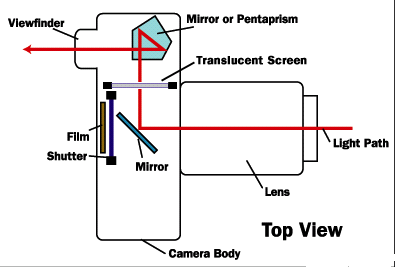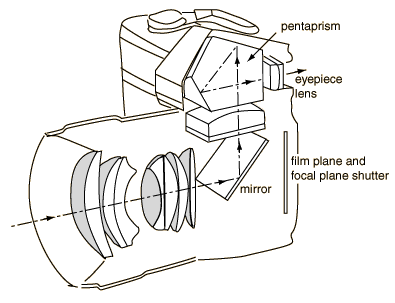The work of a camera – photography is considered to be one of the greatest inventions of mankind. It has not only helped us see the entire world through a click, but has also transformed how people conceive the world. They can also be kept as a remembrance for the rest of our life.
Camera can be defined as a device that is used to capture and record photos or videos.
Early use of camera
Nowadays we see a lot of advanced cameras that are used to capture motion as well as images from a very far distance. During the time of its invention images could be taken only in a room and could not be portable. The instrument should be kept in a dark chamber or box and the room should function as a real-time imaging system. Thus the camera was earlier called “camera-obscura” which meant “dark chamber”. The first of this kind was invented by a scientist called Johannes Kepler. But this apparatus was very huge and could be portable only as a tent. For this instrument to work the light was passed onto it through a convex lens. Thus an image consisting of external objects would be formed which was subjected to the surface of a paper or glass, placed at the focus of the lens. A much compact and portable camera was introduced in 1685 by Johann Zahn.
After years of work by many prominent people the first colour photo was invented by the famous physicist James Clark Maxwell along with Thomas Sutton. Then came the invention of the video made in cameras during the early 1920s. This technology has eventually grown to such heights that in this 21st century, these ordinary film cameras have been replaced by digital cameras.
Parts of a camera
A camera has mainly three parts. They are
- Mechanical part or the camera body
- Optical part or the lens section
- The chemical part or the film
The way in which these three parts are connected represents the different types of cameras. Thus by combining these three parts and using them under the correct calibration produces a correct picture. They are capable of working in both the visible spectrum as well as in other portions of the electromagnetic spectrum. The basic shape of a camera needs an enclosed hollow chamber with an opening at one end. This opening, also called aperture helps in the entrance of light. This light is the actual image that has to be captured. So a capturing mechanism is set at the other end. All cameras have the lens assembled in the front. This lens helps in capturing the light, which is in turn captured and stored by the recording surface. Most ordinary cameras can take one image at a time. Most video cameras can take a maximum of 24 film frames/sec.
Mechanism of a camera
To know the complete mechanism of the camera, it is better to know each and every parameter of the camera.
1. Focus
A camera’s focus greatly depends on the clarity of the picture taken. But the focus can be limited only to a certain distance. This range is limited to the range of the lens. This range when adjusted to get a perfect image is called the focus of the camera. For accurate focussing of cameras, the device is comprised of a fixed focus and also consists of a wide-angle lens and a small aperture in front of the camera. The range of focus will be clearly indicated in the camera with symbols like two people standing upright, mountains and so on. For a simple camera, a reasonable focus of about 3 meters to infinity is available. The focus available on each camera is different. Single-lens reflex (SLR) cameras have a focus that can be changed according to our like. This is done by providing a objective lens and a moving mirror so as to projecting the image to a ground glass or plastic micro-prism screen. Similarly each camera has different settings which will be explained briefly later.
- The focus of a camera depends on two main features. They are
- The structure and position of the lens.
- The angle in which the light beams enter into the lens.
Consider a pencil kept at a short distance from the lens. When the distance is altered, that is kept near and then farther away from the lens, the angle of entry of the light changes accordingly. This light is hit on the film surface kept inside the camera. The angle becomes sharper when the image is close to the lens and will become narrower when the image is kept far away. Thus when the lens is focused farther and then nearer from the pencil, the image is actually moving closer or farther away from the film surface. The correct image will be obtained when the focus is adjusted in such a way that you can line up the focused real image of an object so it falls directly on the film surface.

- Camera Focus

2. Camera Lens
The quality of the photograph taken largely depends on the type of lens used. The precision of a lens depends on a factor called “bending angle”. This in turn, depends on the structure of the lens. If the lens has a flat shape, the bending angle is less. Thus the light beams will converge a little distance farther away from the lens. Thus the image is also formed farther away. Thus when the distance increases, the size of the image also increases, though the size of the film is constant. If the lens has a round shape, the bending angle will be high. Thus the image will be formed a lot more nearer to the lens.
Costly cameras have a lot of lenses, which are replaced or combined according to the magnification required. This magnification power of a lens is called the focal length. Greater the focal length, greater the magnification.
3. Camera Film
For an image to be recorded and viewed it must be stored in a film. When an image is captured, it is actually being “chemically” recorded onto a film. The film mainly consists of millions of light-sensitive grains, which are suspended on a plastic strip. These grains chemically react, when exposed to light. This reaction causes the image to be recorded on the film. This film is then developed by reacting it with other chemicals. For black and white films, the chemicals cause the grains to appear darker when exposed to light. Thus, the darker areas appear lighter and the lighter areas appear darker. This is reversed while printing out the photos.
For producing colour films, the film consists of light sensitive materials that respond to colours red, green and blue. When they are washed and chemically reacted, you get a negative of a colour photo.
Different camera designs
There are a lot of types of cameras like Plate camera, large format camera, medium format camera, folding camera, rangefinder camera and so on. Out of these the most used ones are the single-lens reflex camera (SLR) and the point and shoot camera. The difference comes in the manner in which the photographer visualizes the scene. In a point and shoot camera, you do not see the real image through the camera lens. Instead, you get to see only a blurred vision of the image.
In an SLR camera, you can see the real image of the scee you are about to capture. It has the same configuration as that of a periscope. When the image is seen from the lens, it hits the lower mirror and bounces from there. It then hits the prism. This prism flips the image to form the original image. The mirror and translucent screen help in providing the exact image to the photographer. Thus, you can focus and compose the image so as to get the exact picture you have in mind.

- SLR Camera
With upcoming technology, the point and shoot cameras are nowadays fully automatic. SLR is built with both manual and automatic controls. The only difference between the manual and automatic cameras is that the former will be controlled by a central processor, instead of the photographer.
The focus system and the light meter transmit the signals to the microprocessor and thus activate all the motors accordingly. These motors control the adjusting lens and also open and close the aperture.
Share this on your favourite network







0 comments:
Post a Comment